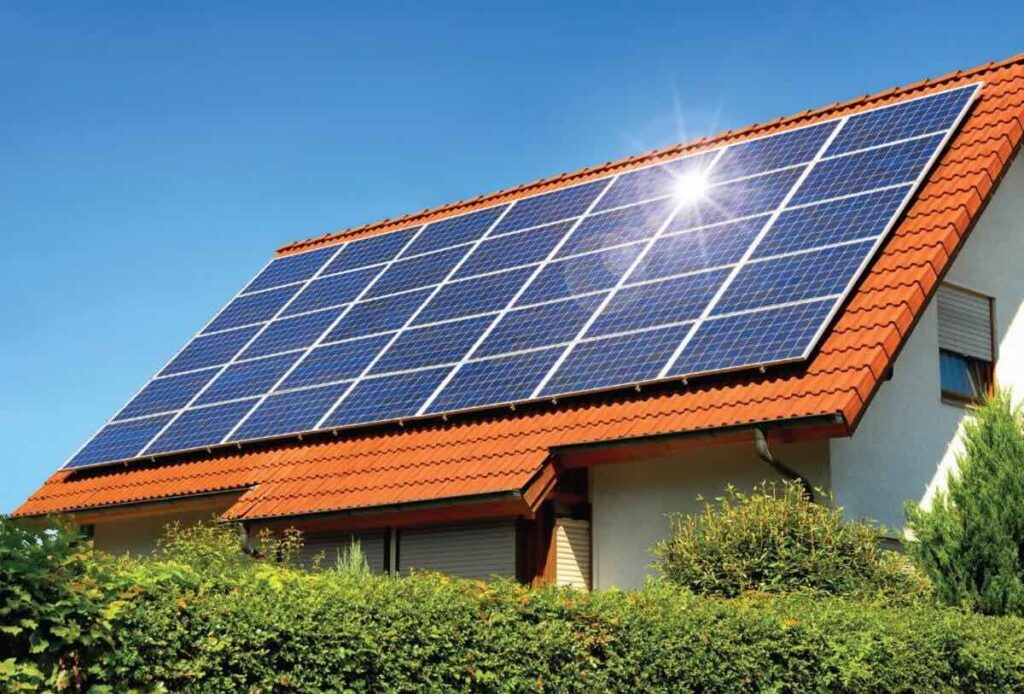Last update January 21st, 2025 at 11:06 am
If you have a big power consumption (and a big roof!), a 10kW solar system might be the right choice. Maybe you have an electric vehicle? Or a big family? If so, you will need a powerful solar panel system to cover your electricity needs.
When it comes to residential solar systems, a 10kW solar installation is among the bigger systems you will find. For businesses with relatively small power needs, a system of 10kW might also be relevant.
Let’s take a closer look at the expected price, savings and rebates for a typical 10kW solar panel system!

How many solar panels will a 10kW solar system need?
In most cases, you will need around 27 solar panels for a 10kW solar system, assuming that the effect of each panel is around 370W.
So, how much roof space would 27 solar panels need? If we assume that each panel has a size of 1.8 x 1 m, this would add up to 48.6 m2. In other words, you will have to cover a significant part of your roof with solar panels.
Remember that the number of panels needed will depend on the panel’s efficiency. As the efficiency of solar panels is getting increasingly higher, you will need fewer panels today than you would some years ago.
What is the expected power output?
On average, a 10kW solar panel system will generate around 40kWh of power every day. To put this amount of power in perspective, it would be enough to cover the electricity needs of two average Australian households.
In other words, a 10kW solar system is not for everyone. But if your electricity consumption is far above the average, it might be a good choice.
However, note that the exact power output might depend on many different factors, including the system efficiency, orientation of the panels, access to sunlight and your location.
Here is the expected power output by area, assuming a system efficiency of 75% and solar panels facing north with a 30-degree tilt:
| Sydney (New South Wales) | 34-38 kWh |
| Perth (Western Australia) | 40-44 kWh |
| Melbourne (Victoria) | 31-36 kWh |
| Hobart (Tasmania) | 29-33 kWh |
| Darwin (Northern Territory) | 42-46 kWh |
| Canberra (Australian Capital Territory) | 36-41 kWh |
| Brisbane (Queensland) | 39-41 kWh |
| Adelaide (South Australia) | 36-41 kWh |
Rebates for a 10kW solar system
In Australia, you are able to claim a solar panel STC rebate when installing a solar system. The rebate size might depend on several aspects, including the system size and the location of your household.
The rebate will usually be bigger for a bigger solar system. This means that the expected solar rebate for a 10kW installation will be bigger than the rebate for a 6kW system.
Remember that you in some areas also may claim a state rebate in addition to the STC rebate, and this will reduce your installation costs additionally.
What does a 10kW solar system cost?
As the STC rebate might differ from one area to another, the expected costs of a 10kW solar system will depend on where you live. Here is an overview of the expected cost in some major Australian cities, after deducting the STC rebate:
In other words, the price can be higher in areas like Darwin, compared to Canberra or Melbourne. But remember, local state rebates might reduce your costs. In these examples, only the STC rebate has been deducted.
It’s important to note that these prices are indicative and can fluctuate based on specific system configurations, installer rates, and available incentives. To obtain the most accurate and up-to-date pricing, it’s advisable to consult with solar installers in your area.
Savings and payback time
When installing a solar panel system, you might expect a financial return as time goes by. This is caused by savings from reduced electricity costs, but also feed-in tariffs that you will earn when selling surplus energy back to the grid.
So, how many years will it take for a 10kW solar system to pay for itself? Many factors will contribute, including your electricity consumption, the feed-in tariff size, panel efficiency and installation costs.
For a 10kW solar system, the payback time is usually somewhere between 2.5 and 6 years. if you live in Sydney and invest in an $8,150 system, the payback time will be 2.8 years assuming an electricity price of 28c, a feed-in rate of 6c and a self-consumption rate of 60%.
Is this the right system for you?
A 10kW solar system will produce around 40kWh of power on a daily basis, which would be enough to cover the electricity needs of two average Australian households. You will probably need around 27 solar panels, and these will cover around 48.6 m2 of your rooftop.
In other words, a 10kW solar system is not for everyone. However, for smaller businesses or households with high power consumption, it might be a great choice! Ask an installer to get the best advice.